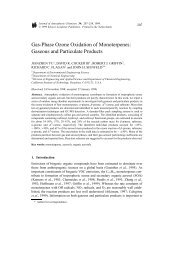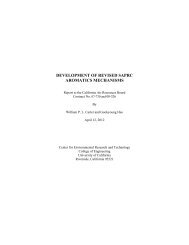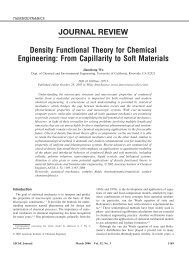Asphaltene precipitation in crude oils: Theory and experiments
Asphaltene precipitation in crude oils: Theory and experiments
Asphaltene precipitation in crude oils: Theory and experiments
Create successful ePaper yourself
Turn your PDF publications into a flip-book with our unique Google optimized e-Paper software.
Figure 11. Comparison between experimental <strong>and</strong> predicted APE for live oil Y3.<br />
parameters k ij were used for <strong>in</strong>teractions among the dissolved<br />
gases (N 2 ,CO 2 ,H 2 S) <strong>and</strong> hydrocarbons (Katz <strong>and</strong> Firoozabadi,<br />
1978). The b<strong>in</strong>ary <strong>in</strong>teraction parameters among the hydrocarbon<br />
components are calculated accord<strong>in</strong>g to the formula suggested<br />
by Chueh <strong>and</strong> Prausnitz (1967)<br />
k ij 1 2Vc i 1/6 1/6 <br />
Vc j<br />
Vc 1/3 i Vc j<br />
1/3<br />
(26)<br />
where Vc is the critical volume <strong>and</strong> is an adjustable parameter.<br />
The values of (Eq. 26) for each live oil ( live oil C1 1.4<br />
<strong>and</strong> live oil Y3 1.65) were obta<strong>in</strong>ed by match<strong>in</strong>g the bubble<br />
po<strong>in</strong>t pressure at 393 K for oil C1 <strong>and</strong> 413 K for oil Y3. Once<br />
the composition <strong>and</strong> density of the oil, at given T <strong>and</strong> P<br />
conditions, are known, the Hamaker constant is then calculated<br />
by Eqs. 5 <strong>and</strong> 11.<br />
Calculation of the APE. The onset po<strong>in</strong>ts of the upper<br />
boundary of the APE for the live <strong>oils</strong> C1 <strong>and</strong> Y3 calculated by<br />
the SAFT-VR EOS, together with the bubble po<strong>in</strong>t l<strong>in</strong>e calculated<br />
by the volume-shifted Peng–Rob<strong>in</strong>son EOS, are compared<br />
with the correspond<strong>in</strong>g experimental data <strong>in</strong> Figures 10<br />
<strong>and</strong> 11, respectively. The APE curves were obta<strong>in</strong>ed us<strong>in</strong>g the<br />
same model parameters fitted for the n-heptane titration data of<br />
the correspond<strong>in</strong>g tank-oil sample (Table 9), except for the<br />
parameters correspond<strong>in</strong>g to SAFT-VR association contribution:<br />
s A , AA , <strong>and</strong> AR . These parameters were determ<strong>in</strong>ed by<br />
us<strong>in</strong>g two APE experimental po<strong>in</strong>ts, at 413 <strong>and</strong> 393 K, for both<br />
live <strong>oils</strong>. The parameters obta<strong>in</strong>ed are given <strong>in</strong> Table 12 <strong>and</strong> the<br />
calculated onset pressures are given <strong>in</strong> Table 13. The average<br />
Table 12. Association Parameters Used for APE Prediction<br />
<strong>in</strong> Live Oils<br />
Live Oil s A AA /k (K) AR /k (K)<br />
C1 2 1685.13 2468.68<br />
Y3 2 1339.96 2476.63<br />
deviations of calculated onsets with respect to the experimental<br />
data are less than 7% error for both live <strong>oils</strong>. In the case of live<br />
oil C1, the model predicts a decrease <strong>in</strong> the onset pressure at<br />
temperatures 370 K. These results <strong>in</strong>dicate that the<br />
SAFT-VR EOS used <strong>in</strong> the framework of McMillan–Mayer<br />
theory provides reasonable predictions <strong>in</strong> live-oil systems.<br />
Moreover, consider<strong>in</strong>g that the <strong>precipitation</strong> mechanisms <strong>in</strong><br />
titration <strong>experiments</strong> differ substantially from those by pressure<br />
depletion, it is particularly reward<strong>in</strong>g to notice that both types<br />
of <strong>precipitation</strong> scenarios <strong>in</strong> the same <strong>crude</strong> <strong>oils</strong> can reasonably<br />
be predicted by the same EOS when most of the model parameters<br />
rema<strong>in</strong> unchanged.<br />
Dur<strong>in</strong>g the reservoir fluid expansion at constant temperature,<br />
the solubility of the asphaltenes is controlled by the screen<strong>in</strong>g<br />
effect of the medium. From Table 14 it is seen how the change of<br />
medium properties dur<strong>in</strong>g pressure depletion modifies the values<br />
of Hamaker constant of the medium (H m ), the attractive meanforce<br />
potential strength between asphaltenes ( AmA ), <strong>and</strong> also the<br />
calculated amount of precipitated material. Above the bubble<br />
po<strong>in</strong>t, the drop <strong>in</strong> pressure reduces the density of the reservoir<br />
fluid, which is reflected <strong>in</strong> a decrement of H m <strong>and</strong> an <strong>in</strong>crement of<br />
AmA , after which asphaltene <strong>precipitation</strong> <strong>in</strong>creases. At the bubble<br />
po<strong>in</strong>t (202.6 bar, at 413 K), the <strong>precipitation</strong> has a maximum value<br />
Table 13. Calculated Onset Pressures for Live-Oil Samples<br />
Us<strong>in</strong>g SAFT-VR EOS<br />
T<br />
P (bar)<br />
(K) C1 Y3<br />
413.15 331.61 401.16<br />
393.15 377.18 455.00<br />
363.15 416.90<br />
354.15 534.89<br />
348.15 386.00<br />
335.15 555.33<br />
Avg. Dev. %* 6.22 6.24<br />
bar 1 10 5 Pa<br />
*Deviation with respect to experimental values.<br />
AIChE Journal October 2004 Vol. 50, No. 10<br />
2565
















